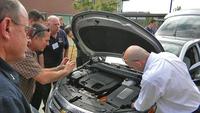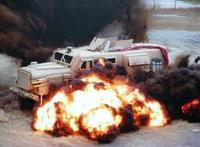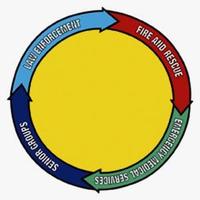-
Terrorists using sophisticated uni-directional bombs
Terrorists have learned to develop increasingly sophisticated explosives as evidenced by the uni-directional bombs detonated last week in Karachi, Pakistan that killed three Pakistan Rangers and injured several others
-
-
FBI opens new forensics lab for local law agencies in New Mexico
Thanks to a sophisticated new FBI forensics laboratory at the University of New Mexico in Albuquerque, local police now have access to cutting edge technology that can help streamline investigations
-
-
Special kits help protect police K-9s
To help keep police canines safe while on duty, the Police & Working K-9 Foundation has teamed up with private and public companies to hold “Cover Your K-9,” an innovative series of technology and training seminars
-
-
Grant helps Kentucky dive team operate without sight
Rescue and recovery divers often struggle to perform their duties in murky, muddy waters, but thanks to a $21,000 grant from Kentucky’s Homeland Security department, the city of Grayson was able to purchase a side-scan sonar and an underwater metal detector to help rescue divers complete their mission in low visibility conditions
-
-
Research may yield more compact antennas for military use
Researchers say that the tall, bulky antennas the U.S. military uses could be scrapped for low-profile, broadband antennas — thanks to a different approach to antenna design that replaces large dipole antennas with a more compact and conformal multi-mode radiator
-
-
New material increases weapons' explosive force
A new material, called High-Density Reactive Material (HDRM), is designed to replace steel in warhead casings with little or no compromise in strength or design
-
-
New sensor system tracks, locate firefighters where GPS fails
With support from the National Science Foundation, electrical engineers are developing a portable device called the Sentrix Tracking Unit; it straps on like a belt and consists of a suite of sensors; the sensors help locates missing firefighters— saving time and maybe lives
-
-
First responders learn how to deal with electric cars

With the growing number of electric vehicles on the road, first responders are now faced with a new type of vehicle that they know little about, which could be potentially dangerous in the event of a fatal crash; to help emergency responders learn about the new technology on the road today, Tesla, a manufacturer of electric vehicles, recently held a training seminar at one of its locations in California
-
-
Research centre to combat devastating effects of roadside bombs

Gaining a better understanding of the injuries caused by roadside bombs and improving both treatment and the means of protection are key aims of a new £8 million research center launched the other day; designing “intelligent” combat boots to deflect the impact of a roadside bomb and diagnosing damage more quickly in the injured to reduce future medical problems are two potential benefits
-
-
Disaster evacuation plans need to incorporate family perspectives
A recent study sponsored by the National Science Foundation found that most respondents felt the evacuation of New Orleans residents to the Superdome after Hurricane Katrina was a “failure” and this opinion has shaped their willingness to accept shelter if offered in an emergency evacuation
-
-
Why law enforcement officers should earn a degree in homeland security
In a guest column, Dennis Porter, a former law enforcement officer with more than thirty years of experience, argues that it is critical for U.S. national security that members of the law enforcement community return to school to obtain degrees in homeland security; with counterterrorism becoming an increasingly more crucial duty for law enforcement officers, it is imperative that they have the skills and knowledge to effectively combat extremism
-
-
Emergency response for the disabled

Roughly 56 million Americans have a disability and with many living without a telephone or television, communicating with them in the event of a major disaster is no easy task; to address the needs of disabled Americans during natural and manmade disasters, emergency officials recently participated in a seminar called “Planning for the Whole Community”
-
-
Iridium offers emergency response service on satellite phone
Iridium offers free SOS service on its Iridium Extreme satellite phone; individuals who need emergency help can now maintain contact with an operator during the emergency rather than rely on one-way SOS alerting
-
-
Local towns signing up for Twitter and Facebook for emergency comm.
Following the lead of several other cities and federal agencies, the town of Wilton, Connecticut recently launched a Facebook page and Twitter account to help communicate with residents and share information during a disaster
-
-
Yellow Dot gets medical info to first responders fast

Emergency officials in Alabama recently introduced a new program aimed at quickly providing first responders with critical information during accidents; in the event of a car accident, first responders will be able immediately to find vital medical information on victims by simply looking in their glove compartment
-
More headlines
The long view
Why Was Pacific Northwest Home to So Many Serial Killers?
Ted Bundy, Gary Ridgway, George Russell, Israel Keyes, and Robert Lee Yates were serial killers who grew up in the Pacific Northwest in the shadow of smelters which spewed plumes of lead, arsenic, and cadmium into the air. As a young man, Charles Manson spent ten years at a nearby prison, where lead has seeped into the soil. The idea of a correlation between early exposure to lead and higher crime rates is not new. Fraser doesn’t explicitly support the lead-crime hypothesis, but in a nimble, haunting narrative, she argues that the connections between an unfettered pollution and violent crime warrant scrutiny.
Bookshelf: Smartphones Shape War in Hyperconnected World
The smartphone is helping to shape the conduct and representation of contemporary war. A new book argues that as an operative device, the smartphone is now “being used as a central weapon of war.”
